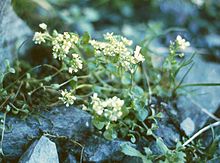Cochlearia
| Scurvy-grass | |
|---|---|
 |
|
| Cochlearia officinalis subsp. pyrenaica | |
| Scientific classification | |
| Kingdom: | Plantae |
| (unranked): | Angiosperms |
| (unranked): | Eudicots |
| (unranked): | Rosids |
| Order: | Brassicales |
| Family: | Brassicaceae |
| Genus: |
Cochlearia L. |
| Species | |
|
About 25 species, see text |
|
About 25 species, see text
Scurvy-grass (Cochlearia species; also called scurvy grass, scurvygrass, or spoonwort) is a genus of about 30 species of annual and perennial herbs in the cabbage family Brassicaceae. They are widely distributed in temperate and arctic areas of the northern hemisphere, most commonly found in coastal regions, on cliff-tops and salt marshes where their high tolerance of salt enables them to avoid competition from larger, but less salt-tolerant plants; they also occur in alpine habitats in mountains and tundra.
They form low, rounded or creeping plants, typically 5–20 cm tall. The leaves are smoothly rounded, roughly spoon-shaped (the scientific name Cochlearia derives from the Latinized form, cocleare, of the Greek κοχλιάριον, kokhliárion, a spoon; this a diminutive of κόχλος, kókhlos, seashell), or in some species, lobed; typically 1–5 cm long, and with a fleshy texture. The flowers are white with four petals and are borne in short racemes.
About 30 species are usually accepted; several others usually treated as subspecies of C. officinalis are accepted as distinct species by some botanists.
Two species formerly included in the genus Cochlearia are now usually treated in separate genera:
Cook's scurvy grass, Lepidium oleraceum, was used by James Cook to prevent scurvy, but is now almost extinct.[1]
...
Wikipedia
